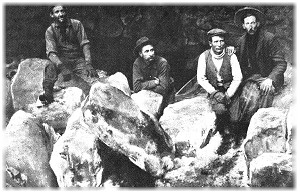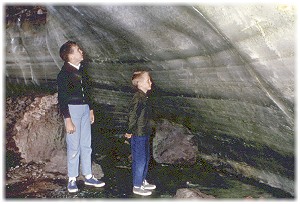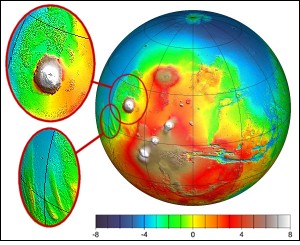 |
Oregon L5 Society |
|
Introduction: Ice in Martian lava tube caves would have scientific and developmental value. These natural channels in rock may hold keys to Mars' past as well as potential resources for humanity's future.
Many of the lava tubes in the Central Oregon area sport such names as "Arnolds Ice Cave," "Surveyors Ice Cave," "South Ice Cave," etc. These caves are not caves in ice, but rather common lava tubes with seasonal, and sometimes perennial ice deposits. Locating and cataloging similar features on Mars, could be of value for the colonization of Mars and the search for life. Such features may also prove useful in helping to determine past climatic conditions on the Red Planet.
Explanation: On Earth, where climate and cave structures are favorable, freezing air settles into lava tube caves and is kept below freezing by basalt insulation (Fig. 2) When the weather warms, liquid water flows into the cave and freezes solid. The layers of water can freeze year after year, sometimes completely filling the cave. In this way, records of past climate can be preserved in the ice. Debris, including organic debris, washed into the cave can be frozen and preserved. During past warm and wet periods on Mars, these same mechanisms may well have existed. Scientific Value: Cave ice deposits can be important for a number of reasons. First and foremost, the ice has potential for use by Mars explorers and settlers. The ice may also contain various components that could answer a number of questions about Mars. Trace elements could provide records of past climates. By analyzing layers of different deposits and (or) dissolved gases, a better picture of the Mars of yesteryear could be obtained. Materials washed into the cave and frozen in the ice can show what surface conditions existed in the past. This would be especially important in determining how these conditions were different than today. Gas bubbles preserved in ice could provide a snapshot of an earlier Martian atmosphere. Long term climate fluctuations could be preserved in the ice record.
Remote Detection of Cave Ice: Direct detection of cave ice deposits from orbit may prove difficult, if not impossible to accomplish. Secondary effects associated with lava tubes may be possible to detect however. Many terrestrial caves were discovered in this manner. Some caves on Earth "breathe" due to the inertial lag in equalizing the large cave volume when outside air pressure changes. Valentine Cave in northern California was discovered on a clear cold winter day by observation of a steam-like cloud plume rising from the entrance[1]. The Lavacicle lava tube in Central Oregon was discovered by firefighters, mopping up after a large forest fire. One of the crew observed a column of clean air rising through the fire's smoke, and discovered an entrance into the cave [2]. Similar effects may occur in the still, dusty air after one of Mars' frequent dust storms. By analyzing the densities of suspended dust above surfaces of lava flows, we may be able to effectively detect "exhaling" entrances to these caves. Aeolian deposits around cave entrances may be an indicator of this effect. Other techniques, such as surface-deployed ground-penetrating radar, might prove useful to detect cave ice deposits. The radar signal responds to changes in dielectric constant of different materials that might indicate the presence of ice. Likewise, a radar "flashbulb" might be employed, making use of kinetic energy to create a loud radar "burst" that would yield similar data. However, other techniques may be necessary to locate potential sites before this technique could be employed. A neutron reflectance spectrometer might be made to work, which would detect ice signatures. Sonographic techniques such as geologists use to identify buried features may be able to detect cave voids, but discriminating the signature of ice may be problematical. Finding lava tube caves on Mars is pretty easy, in that numerous indicators of lava tubes have been identified from orbit as far back as Viking, with new data from MGS providing a better view. However, where to look for lava tubes that may contain water is a different matter. Most of the volcanic areas of Mars are located in higher elevations, such as the Tharsis plateau. Assuming that wet, warm conditions in the past were conducive to water drainage into cold caves, logically we should narrow our search to those tubes located in lower areas.
It is our opinion that the northwest flanks of this area would be an ideal place to look for such features. A host of igneous flow features, including lava tubes, have been identified in this area. Combining this with its relative close proximity to the possible northern ocean, as well as a lower elevation than other similar areas, makes this an attractive area to search for ice caves. The ice within lava tubes may prove to be an ancient document of Martian maritime conditions. Confirmation of Cave Ice: Once a candidate cave is located, the next step would be to examine it for signs of ice or other volatiles. Options may include the use of robotic "insects" communicating via a self-deploying, self-optimizing, cellular network, [4]. In this scheme, a series of "insect robots" enter the cave, and install a series of communications relays as well as a central "base" where they can periodically return to recharge power systems. These robots could also be used to map a cave as they go. A flying probe may turn out to be more practical than navigation over a rockfall-strewn cave floor. Cave exploration appears to be a significant challenge to current robotics, and may require human explorers. Of course, those explorers will need to be in communication with their peers on the surface. Several schemes for this have been proposed, such as optical fiber deployment, extra low frequency radio, sonic transmission through rock, and low-frequency free air acoustical signaling. The latter method may even be an effective way of determining the density of gases within caves. Developmental Value: Lava tube caves could be desirable sites for long term habitation on Mars, due to the natural shielding afforded by the thick layers of basalt making up the structure [5]. Habitats built in lava tubes would not require extensive shielding, and could in fact be nothing more than tough inflatable domes. Light could be channeled in with large inflatable versions of "Solatube" skylights, making use of the same effects that fiber optics use, only without the mass. A large, long inflatable cylinder with mirrored sides could bounce light into a cave. Owing to the reduced gravity, Martian lava tube caves would dwarf their terrestrial counterparts. Finding an available deposit of frozen water may add the frosting to the cake, making lava tube habitats not only possible, but desirable. References: [1] Larson, C & J (1990) "Lava Beds Caves", footnote, 12. [2] Larson, C. V. (1982) "An Introduction to Caves of the Bend Area", 48. [3] Dohm, J. M., Anderson, R. C., (2000) Sky and Telescope, "Newsfronts: More Martian Floods?" June, 2000 Vol. 99/No. 6, 24. [4] Boston, P. J. (2000) NASA Tech Memo, "Human Utilization and Exploration of Subsurface Extraterrestrial Environments: Technologies and Test Beds". [5] Walden, B. E. 1988. "Lunar base simulations in lava tubes of the Pacific Northwest". AAAS Pacific Region Meeting, Corvallis, OR. June, 1988."
Home | Intro | New Info | Join | LBRT | MIST | Space | Discussions | Contacts | Links |



